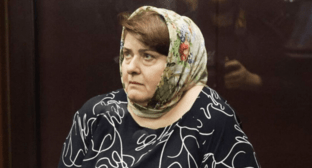22 May 2004, 20:55
Chechnya, spring 2004: 'normalization' details
Multiple reports about successful fight against separatists and terrorists have been coming in from the Chechen Republic over this entire spring. It is generally preferred not to mention, so to speak, the "costs" of this fight - dying or "disappearing" residents of Chechnya. When such information does become public, spokespeople of federal law enforcement and security agencies try to disavow them in some or other way. Last week, they commented twice on the episodes the Memorial Human Rights Center had previously reported.
* * *
It is all about the two tragic events.
Maidat Damaeva with her five children - four years, three years, two years and two twins aged nine months - were killed by a an air strike on the mountain village of Rigakhoi, Vedeno district, on April 8, 2004. The Air Force command denied having bombed this village, and there was a report with reference to the prosecutor's office that the family had died as a result of a homemade bomb blast. That is, the responsibility for the tragedy was indirectly shifted onto the dead people themselves who were allegedly connected with armed units of the separatists.
Nine bodies with traces of torture and signs of violent death were found near Serzhen-Yurt, Vedeno district, on April 9, 2004. Eight of the people had been abducted from Duba-Yurt on the night of March 27, and the circumstances indicated the involvement of federal forces in this - representatives of Human Rights Watch (HRW) and Memorial spoke about this at a press conference on April 8. However, representatives of the Regional Operational Headquarters for the conducting of the counter-terrorist operation in the North Caucasus again accused separatists of the abduction and following killing: what happened was said to be revenge on Duba-Yurt residents who had refused to supply guerillas with food.
The statements by the press services for the Air Force and Regional Operational Headquarters cannot be called a disproof though: it is a denial without any valid substantiation - in both cases, the statements by the spokespeople do not even show traces of plausibility.
* * *
First reports about the tragedy in Rigakhoi erroneously dated it to April 9, so the Air Force command's spokesperson "honestly" maintained: there were no flights on that day. By the way, Chechen administration representatives committed the same dating error, too. Besides, those first reports by Memorial repeatedly said: the information is just provisional and there might be inaccuracies which, however, would be corrected right away. But even when Memorial corrected that error and when the representatives of the Kadyrov administration began to use the right date and speak about the tragedy in Rigakhoi at the top of their voice, the Air Force press service continued to play the same record: "no flights on April 9."
The prosecutor's office representatives that had verbalized the version that the woman and her children had died as a result of a "homemade bomb blast" were not at all confused by the fact that the explosion had occurred outdoors, not inside their house. The woman and her children were covered with debris, no missile wounds or mine explosion traumas can bee seen. Besides, the videotape gives a clear sight of the crater from a second piece of ammo some distance away from the house - so what, was that a second "homemade bomb blast"?
The marking can be seen on the preserved fragments of the piece of ammo that killed the Damaevs, so it is not going to be a problem for the investigation to establish its type and number, the combat machine that had carried it and the pilot that had controlled the machine.
* * *
The statements that rebels abducted the Duba-Yurt residents are as unfounded.
Firstly, two armored personnel carriers were involved in the detention on the night of March 27, while rebels have no armored personnel carriers.
Secondly, residents of the village followed the column with the detainees - it went along the Shatoi-Grozny highway past Starye Atagi towards Khankala.
Thirdly, the villagers were able to find out in the next days that the detained people were in Khankala. HRW even came to possess a photocopy of the record about a prosecutor's inspection that led to finding all the detainees exactly there, at the main federal base in Chechnya.
Finally, the ninth body from among those found near Serzhen-Yurt belongs to a person coming from Duba-Yurt but resident in Grozny whom federal law enforcement / security agencies detained on the night of April 2 in Grozny's Oktiabrskii district.
That is, "Chechen rebels" could have been involved in the crime in Serzhen-Yurt only if they had armored vehicles in their arsenals, could freely pass road posts and had their base in Khankala and besides, detained and gathered in one place natives of a village. Or maybe the representatives of the Regional Operational Headquarters seriously maintain that the "rebels" that had not obtained provisions in Duba-Yurt paid a visit to Grozny a week later and abducted a native of that village there?
* * *
Russian official agencies more than once reported victories in fight against terrorists in April 2004. However, no one seems to have canceled the effect of Russian laws in Chechnya as yet. No one has officially placed the "counter-terrorist operation" and its participants outside law, freed them from responsibility for offense against the law. Killing civilians - a woman and children - is criminal. Likewise, people detained in the course of the "counter-terrorist operation" and kept by representatives of the Russian state must not be subject to torture and extrajudicial execution. Such actions are not only criminal as they are, not only put government on a par with gangsters - they also create preconditions for a new wave of terror in Russia. Not only those who killed and tortured, but also those who covered up murderers and hangmen will be responsible for that.
April 20, 2004
Author: Alexander Cherkasov, Memorial Human Rights Center (Moscow) Source: Memorial Human Rights Center (Moscow, Russia)




